
(Photos: PBOT)
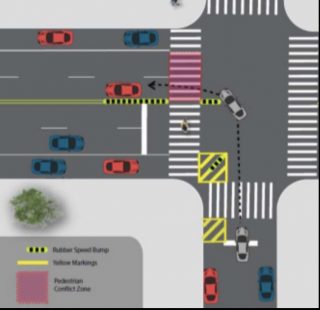
The Portland Bureau of Transportation wants to make intersections safer by slowing down drivers making left turns. To accomplish this, PBOT is testing the use of modular speed bumps. The bumps act as curbs that encourage people to take more angular turns instead of cutting them at high speeds.
The bumps are made out of a composite material and are screwed into the pavement. Yesterday PBOT staff installed two different version of them in the Albina Yard maintenance facility and rode over them with a bicycle, a truck, and a motorcycle. They also sprayed them down with water to see if they got slippery.
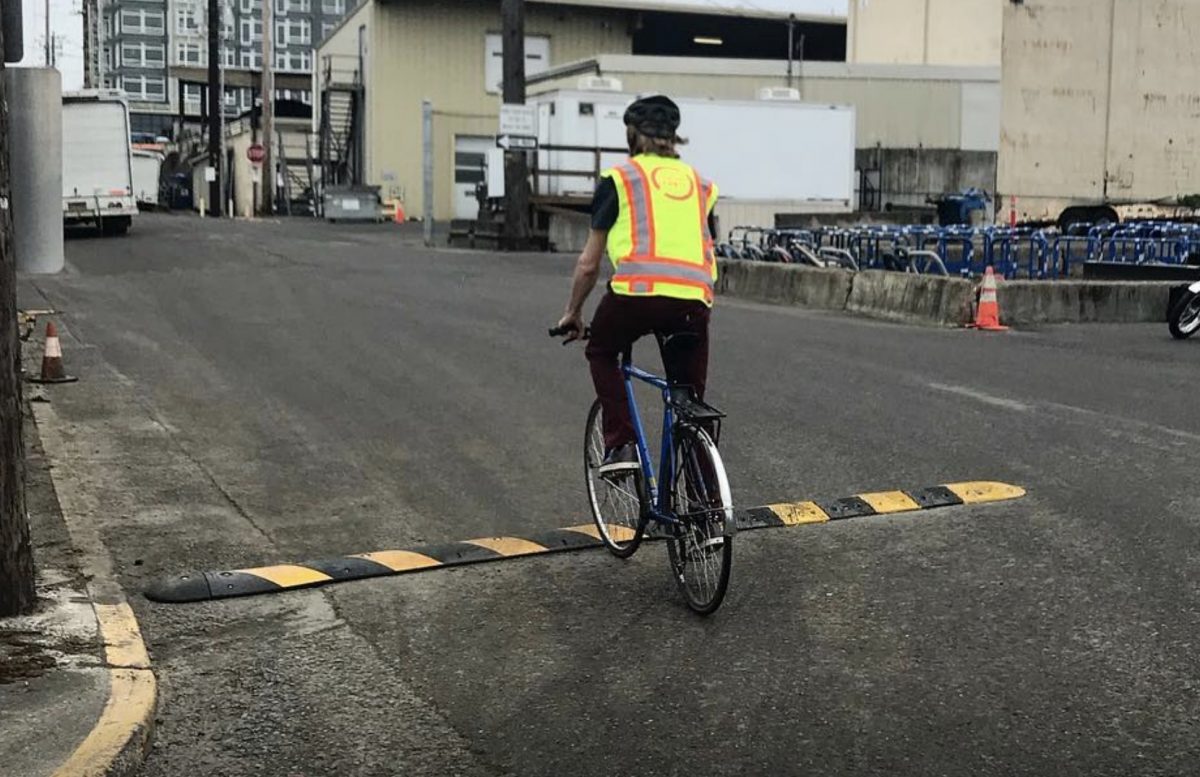
According to posts on social media, PBOT says they, “Wanted to see what these bumps felt like for bike riders of both variety, particularly if the had enough traction when hit at an angle, when wet.”
Advertisement
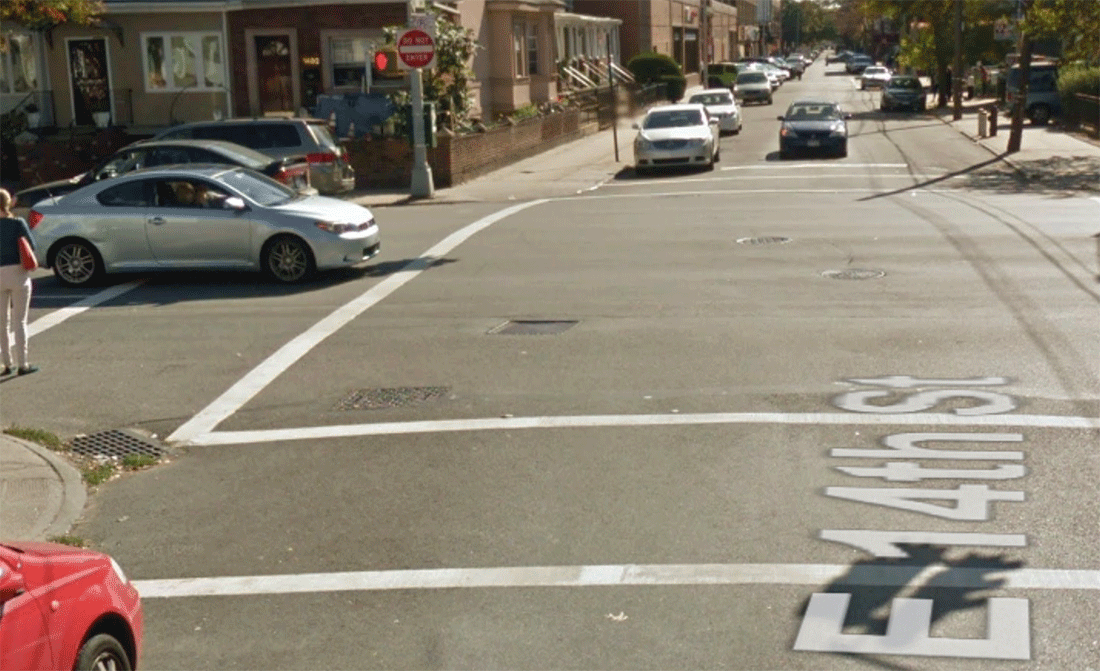
New York City already uses them extensively as a method of “left turn calming”.
And as you can see in the example above from New York City (which PBOT linked to), the bumps could be placed directly in the path of a bicycle rider. In a post yesterday, PBOT wrote, “These bumps are placed so bikes won’t have to ride over them much, but we know there may be times a cyclist has to go over one, so we want to make sure the design we choose is safe.”
These speed bumps appeal to PBOT not only as a speed and dangerous turn deterrent, but because they could be installed relatively quickly.
Of the two designs under consideration; one is wider with more aggressive treads, and the other is narrower with fewer tread lines. Once a style is chosen, they plan to use them at high crash intersections with a history of collisions involving bicycle riders and walkers.
Stay tuned for more on these if PBOT hosts a test that’s open to the public. Once they are in the wild we’ll give them a closer look.
— Jonathan Maus: (503) 706-8804, @jonathan_maus on Twitter and jonathan@bikeportland.org
Never miss a story. Sign-up for the daily BP Headlines email.
BikePortland needs your support.



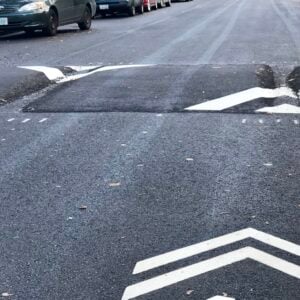
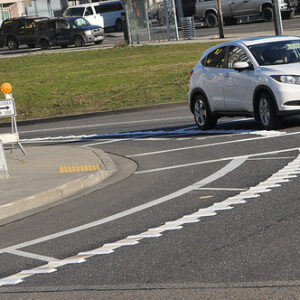

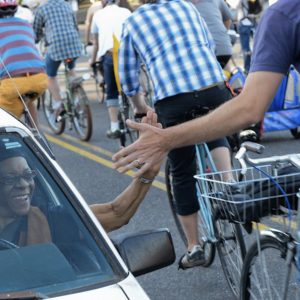
Thanks for reading.
BikePortland has served this community with independent community journalism since 2005. We rely on subscriptions from readers like you to survive. Your financial support is vital in keeping this valuable resource alive and well.
Please subscribe today to strengthen and expand our work.
I’m not sure why this would impact biking at all—wet or dry. They’re cheap replacements for concrete medians and pedestrian crosswalk caps.
You probably couldn’t do this in front of crosswalks where crossbikes are also installed, yes. But for other locations with only crosswalks I imagine this won’t be an issue for bike users.
We don’t really ever think of concrete refuge islands in the middle of crosswalks as dangerous for bike users. Riding a bike puts you pretty low to the ground and everything is visible. I find it hard to believe bike users turning will consistently ride over these, placing them in danger. Drivers of vehicles on the other hand is another story, but it would be a jolting bump, nothing dangerous (meaning it did it’s job—you, driver, did a poor job turning)
In the graphic and the NY photo the bump sticking out in the street (that the car is running over) is exactly where you’d want to be on a bike. So cyclists will have to actively avoid it. Drivers don’t even have to slow down for such a trivial bump.
Looking at the example intersection is a little awkward as both the road the camera is on and oncoming are one ways converging on to a two way. The lanes the bumps are in front of are parking lanes, not travel lanes. I haven’t seen an example of a standard intersection yet.
Looking above to the graphical example, the bump does not extend into a straight through travel lane, only parking lanes.
I agree, D2. It’d be interesting to see diagrams for other types of intersections, especially given that the one shown isn’t very typical.
The graphic shows a car going around the bump. This puts the driver in the middle of the intersection in conflict with turning driving coming from the opposite direction. Separate signals would be needed. With such an obstacle the driver is likely to complete their turn in the right-side (incorrect) lane.
The photo shows what really happens, the driver goes over it. This is also the path of bicyclists and motorcyclists, both of whom will actively try to ride around it.
Speed bumps don’t slow people down, they just keep some people from going too fast. With these bumps being in the road they have to be able to be drivable at the speed limit or they’re a hazard.
If drivers are cutting the center line then put in a hard barrier along the center line, like a real curb, that hurts when you hit it. If they’re taking the corner too fast then put in a stop sign. These are simple solutions that already work.
This is supposed to be a reply to “Johnny bye Carter” the nesting replies have been funky for me recently, sorry.
Check out the full website – drivers do make it over fine (and it’s a truck in the example that does it correctly). https://qz.com/1315305/one-small-change-to-new-yorks-intersections-is-saving-pedestrians-lives/
“If drivers are cutting the center line then put in a hard barrier along the center line, like a real curb, that hurts when you hit it. If they’re taking the corner too fast then put in a stop sign. These are simple solutions that already work.”
As far as the other concerns you brought up – it seems like it’s working great in nyc. these aren’t meant as marquee treatments, but low cost quick builds until better upgrades come along. An upgrade sidewalk with bulb outs and sharper turning radius to reduce vehicle speeds is great. I’m not disagreeing with you. However, I’m being practical. It costs a lot of money for those upgrades. This will be cheaper until those other upgrades come along. I’m with you – when I drive across bridges, the sidewalks look like they’re much higher than normal sidewalks –maybe 6inches tall vs 4inches on normal roads. I love it! It makes me terrified and I drive much slower. But that’s also very expensive.
Stop signs if overused don’t do much to deter / modify driver behavior. That’s why protected intersections are becoming popular too. If the traffic signals were all that was needed to protected pedestrians/bicyclists, we wouldn’t have a large portion of our injuries in intersections
The NYC examples are where one way streets meet at 2-way streets, as in the photo.
I completely disagree; traffic-calming hardscape like concrete curb extensions and medians can be incredibly dangerous for cyclists and motorcyclists, and with the rising popularity of faster E-bikes, should only be installed/used with extreme care.
Those yellow plastic tactile markers at ADA curb ramps can be incredibly slippery in the rain as well, very dangerous for two-wheeled vehicles.
Sorry, blind people. I need to go fast on this pedestrian infrastructure! Out of my way!
How fast are you turning that you can’t see those large concrete refugee islands that are usually painted yellow and have reflective pieces? People generally do an ok job of avoiding sidewalks when they turn right too. The point of the refugee islands/crosswalk caps is to make turning safer so vehicles don’t hit pedestrians. Sounds like they’re doing the job…
As for the ADA ramps – PBOT has been using them in green color then a cycle track meets an intersection. I’ve ridden the SW Moody one plenty of times and haven’t had an issue. If you’re crossing a yellow ADA ramp – so you’re riding in the sidewalk, it’s probably best to be going slower anyways to avoid hitting a pedestrian.
The argument that because we are getting fast E bikes, we should do away with pedestrian safety items parallels what drivers of motor vehicles want – go fast at the expense of others. Let’s try to avoid falling into that trap.
Eh — actually, your eye level is higher on a bike than it would be in many cars (especially if you’re tall or not on a recumbent). It’s just that far less is blocking the view of the ground in front of you.
I like this idea. But my gut reaction is also, “Oh man, I don’t want to ride over one of those on my motorcycle in the rain.” But if they say they’ve tested it and it’s fine then whatever.
Screwing with the traction of a motorcycle while it’s leaned over and turning is a good way to dump me on the ground though. What’s probably going to happen is that I’ll have incentive to slalom between them so that I don’t have to ride over them. The feeling of having your rear tire slip out from under you is the worst.
This is great! Fun to see how PBOT is testing these out for a range of users. Thanks for sharing this!
I’d like to see small cut-outs for bike wheels. They also should be BRIGHT YELLOW so they can be easily noticed–sometimes there is a lot going on in an intersection and a cyclist may not be paying attention to the ground. If one caused a cyclist to fall it is in a VERY bad location to be on the ground.
Yay! “Hedgehogs” are here!!
PS. perhaps some reflectorized RPMs may need to be added for winter/ nighttime awareness for cyclists/ motorcyclists?
In the example NYC photo, it looks like one of the barriers is in the path of the bike lane. Will these barriers be placed in the path of bike lanes or shoulders? I ride across two of these daily and they definitely can agrevate an existing back problem.
I’m all in favor of adding some tactile reminder that might help people to safely execute a left turn without wandering across half the crosswalk and cutting over the center line, but the exact implementation in the example looks odd to me. It’s almost as if they’re placing one of these things parallel to the lane as it enters the intersection in place of a “slow turn wedge” with plastic bollards. The result, from a bike rider’s point of view, looks like kind of a weird gauntlet of plastic curb thingies, some perpendicular to my path and some parallel.
It’s a cool idea, but I hope we do it a little differently here in Portland.
In the before/after NYC photo, I see three bumps installed: two that are parallel to each other, and one that runs perpendicular to those other two. That one bump looks like it runs transversely across any bike lane that would be running from left to right across the pictured area. It also appears that odd, perpendicular bump—while aesthetically pleasing because it creates a sense of “corner”—is completely unnecessary to serve the purpose for which it is intended.
Were we to do this in Portland, I would hope the transverse bump piece would be left out. It would save money and pain.
A PBOT staffer in the Vision Zero group told me recently that PBOT has noticed that drivers turning left and running into people walking in crosswalks happens frequently. So it’s great to see PBOT is responding to the problem. It happens to me frequently–light turns green, I start across, and the driver who’s been first in line in the turn lane and able to see me for 30 seconds accelerates directly at me as if they’re blind.
I don’t know if this is the right solution or not. Concerns people have seem valid.
I definitely see the use for these in neighborhoods. When my son bikes in our neighborhood, there’s a long cul de sac he regularly rides out of, and I make sure he’s riding as far to the right as he can, even when there’s nobody else on the street. I regularly see drivers turn left into that cul de sac without slowing down and cutting the corner, going just a foot or two away from the curb on their left. If that ever happens when he’s riding up to the intersection in the middle of the lane, he’s in big trouble.
Unfortunately, I wouldn’t rule out drivers turning left SOONER to avoid hitting the bump in the intersection–driving in the crosswalk BETWEEN the bumps, hitting anyone (such as the woman in the NY photo) whose halfway across.
For the naysayers, as a bicyclist/pedestrian/runner in NYC that is often with my 3 year old, these things WORK. In my neighborhood I can probably count a good 40 of them. They are going in at lightning speed and you can see the difference. Drivers have two choices when they see them a) make the turn wider and more deliberate or b) they decide to go over them which actually slows the cars down quite a lot.
They work. Everyone in my neighborhood talks about seeing them making the intersections at more calm. Do they slow bikes? Maybe a smidgen. Who cares, I will take drivers having to be more deliberate any day versus me on a bike having to go 12mph vs 14 or 15. Besides once you know where they are, you can usually anticipate based on conditions what your best route thru or around them.
And pair these with Leading Pedestrian Intervals (LPI’s) like they have done they have been able to make hundreds of intersections safer for very little cost. But if they actually have to put in curb infra or other comprehensive measures who knows if we would get a half dozen for the same budget.
Comment of the week! (Clarence Eckerson’s post)
Aloha Clarence – thanks for chiming it and sharing NYC experience. (And Happy Fatherhood!)
Thanks Todd. This is one of the positives of having a 3 year old son who understands a lot of transportation. LOL! https://vimeo.com/212846367
It sounds like a good device to keep drivers from making hasty turns–a good thing to make ’em look where they are going first!
Um, aren’t pedestrian deaths up significantly in NYC this year compared to this time last year? Whatever NYC is doing, I’ll take something else, thank you very much.
Besides, I’ve got enough moving objects to look out for while riding. I don’t need more obstacles on the road surface that restrict my approach and escape routes from intersections.
Low cost, easy install, low maintenance, demonstrated effectiveness – those qualities check the right boxes for me. I wish similar speed bumps were installed at the stop line of roads crossing our neighborhood greenways to serve as a gentle reminder that the nose of the car stops at the stop sign, not a quarter of the way into the intersection.
They look less harsh than the average lumps and holes all over every street in this town. Make ’em bigger.
Thanks for the firsthand intel, Clarence. Maybe we just need to see/experience them in person!
i hope these would encourage drivers to actually pull into the intersection while waiting to turn left but they probably still won’t.
I noticed this too in the example image. It may be the result of the street designs in the greater New York City area where opposite-direction, one-way streets terminate with each other at intersections and is an intention design strategy to limit cut through access along side streets. It can be paired with contraflow bike lanes to develop bike routes where space is limited and there is noncompliance among people driving cars off of the neighborhood collectors.
Comment of the week
I’d love to see these deployed at crossings in East County (e.g. 180th, 162nd, 148th, et al).
I don’t understand why the crosswalk doesn’t just have soft bollards extended through it to the intersection. This would force vehicles to do the same thing without slippery bumps in the road and it would be far cheaper. Pedestrians & bicycles can filter through bollards. Cars will go around them.
Cars would mow them down and destroy them. See: every single “soft” bollard installation in Portland.
Yes, they started doing many of these style treatments with bollards. Which would last a few days to weeks to months. These suckers in the ground are pretty solid. We didn’t have an insane amount of snow this year in NYC, but we had a few storms with plows out and I didn’t see a single one damaged – yet always seem broken or dislodged bollards following storms.
They should cover everything and test them on a rainy night with drivers, motorcyclists, and bikers.
It’s pretty obvious these traffic calmers succeed in good weather and natural light.
Portland used to have dozens of small concrete ‘turtles’ with a light inside that did this exact thing: prevented drivers from cutting turn too sharp. Old is new…
I just had a bike accident going over one of these damn things yesterday. I’m lucky I only got banged and scraped up. I didn’t see the “bump” as I tried to avoid a jaywalking pedestrian, and when I hit it my hands got knocked off my handle bars and I crashed. I think, based on my experience, that they’re going to cause far more accidents and than they prevent. Bad design!
At the intersection of MLK and Dekum I witnessed a motorcyclist hit one of these barriers and almost lost complete control of their bike barely recovering before colliding into the curb and and a pedestrian waiting to cross. A!!I dont feel like this is a good idea at all. Physical obstacles cluttering the roadway complicate things and bring new list of dangers. The problem is driver awareness and recklessness so add a flashing light if your worried about crossing pedestrian because the reckless or unaware driver will only be made mor
They are traffic calming devices, not barriers, with a proven track record of slowing motor vehicles down at intersections ( and in this case high crash intersections for walkers and cyclists).